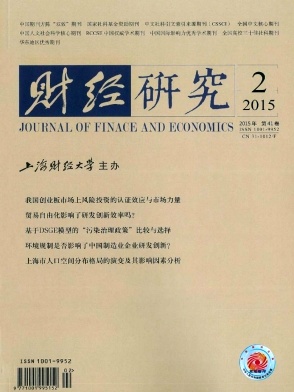相对增进型技术进步和我国要素收入分配——来自产业层面的证据
财经研究 2015 年 第 41 卷第 02 期, 页码:88 - 98
摘要
参考文献
摘要
现有文献研究劳动收入占比下降往往集中于非技术因素,而从技术视角考察要素收入分配问题将更具普适性和解释力。为此文章从相对增进型技术进步入手,构建总量和产业两个层面的要素收入分配作用机制模型,发现总量层面要素收入分配同时受产业结构和产业层面要素收入分配的影响,其中相对增进型技术进步和要素禀赋是影响产业层面要素收入分配的两个重要因素,而要素替代弹性则决定了其作用方向。经验结果显示:总量层面要素收入分配变化更多来源于产业间要素收入分配的差异,而产业结构作用则相对微弱;产业层面要素收入分配中相对增进型技术进步起着主导作用,其在不同产业中对劳动收入占比的影响是不同的,而要素禀赋的直接影响有限,其在第一产业中的作用为负向而在第二产业中的作用则为正向。为此政府制定要素收入分配结构优化政策时,应更多着眼于对技术进步方向的引导和经济结构调整。
[1]白重恩,钱震杰.国民收入的要素分配:统计数据背后的故事[J].经济研究,2009,(3):27-41.
[2]戴天仕,徐现祥.中国的技术进步方向[J].世界经济,2010,(11):54-70.
[3]范晓静.对中国产业资本劳动替代弹性的估计[J].统计与决策,2014,(6):159-162.
[4]黄先海,徐圣.中国劳动收入比重下降成因分析——基于劳动节约型技术进步的视角[J].经济研究,2009(7):34-44.
[5]李稻葵,刘霖林,王红领.GDP中劳动份额演变的U型规律[J].经济研究,2009,(1):70-82.
[6]李仁君.中国三次产业的资本存量测算[J].海南大学学报(人文社会科学版),2010,(2):47-52.
[7]罗长远.卡尔多“特征事实”再思考:对劳动收入占比的分析[J].世界经济,2008,(11):86-96.
[8]罗长远,张军.劳动收入占比下降的经济学解释——基于中国省级面板数据的分析[J].管理世界,2009,(5):25-35.
[9]王林辉,韩丽娜.技术进步偏向性及其要素收入分配效应[J].求是学刊,2012,(1):56-62.
[10]王林辉,董直庆,刘宇清.劳动收入份额与技术进步偏向性[J].东北师大学报,2013,(3):33-39.
[11]Acemoglu D.Directed technical change[J].Review of Economic Studies,2002,69(4):781-809.
[12]Acemoglu D.Patterns of skill premia[J].Review of Economic Studies,2003a,70(2):199-230.
[13]Acemoglu D.Labor-and capital-augmenting technical change[J].Journal of the European Economic Association,2003b,1(1):1-37.
[14]Bentolina S,Saint-Paul G.Explaining movements in labor share[J].The B.E.Journal of Macroeconomics,2003,3(1):1-33.
[15]Blanchard O.The medium run[J].Brookings Papers on Economic Activity,1997,28(2):89-158.
[16]Harrison A E.Has globalization eroded labor’s share?Some cross-country evidence[R].MPRA Paper No.39649,2002.
[17]Kaldor N.Capital accumulation and economic growth[A].Lutz F A,Hague D C,The theory of capital[C].New York:Martin Press,1961.
[18]Kravis I B.Relative income shares in fact and theory[J].American Economic Review,1959,49(5):917-949.
[19]Kessing S G.A note on the determinants of labor share movements[J].Economic Letters,2003,81(1):9-12.
[20]Klump R,McAdam P,Willman A.Factor substitution and factor-augmenting technical progress in the United States:A normalized supply-side system approach[J].The Review of Economics and Statistics,2007,89(1):183-191.
[21]Di Maria C,Valente S.The direction of technical change in capital-resource economies[R].MPRA Paper No.1040,2006.
[22]Solow R M.A skeptical note on the constancy of relative shares[J].American Economic Review,1958,48(4):618-631.
[23]Young A T.One of the things we know that ain’t so:Is U.S.labor’s share relatively stable?[J].Journal of Macroeconomics,2010,32(1):90-102.
[24]Zuleta H.Why labor income shares seem to be constant[J].The Journal of International Trade Economic Development,2007,16(4):551-557.
[25]Zuleta H,Young A T.Labors shares-aggregate and industry:Accounting for both in a model of unbalanced growth with induced innovation[R].Documento de Trabajo No.003105,2007.
[2]戴天仕,徐现祥.中国的技术进步方向[J].世界经济,2010,(11):54-70.
[3]范晓静.对中国产业资本劳动替代弹性的估计[J].统计与决策,2014,(6):159-162.
[4]黄先海,徐圣.中国劳动收入比重下降成因分析——基于劳动节约型技术进步的视角[J].经济研究,2009(7):34-44.
[5]李稻葵,刘霖林,王红领.GDP中劳动份额演变的U型规律[J].经济研究,2009,(1):70-82.
[6]李仁君.中国三次产业的资本存量测算[J].海南大学学报(人文社会科学版),2010,(2):47-52.
[7]罗长远.卡尔多“特征事实”再思考:对劳动收入占比的分析[J].世界经济,2008,(11):86-96.
[8]罗长远,张军.劳动收入占比下降的经济学解释——基于中国省级面板数据的分析[J].管理世界,2009,(5):25-35.
[9]王林辉,韩丽娜.技术进步偏向性及其要素收入分配效应[J].求是学刊,2012,(1):56-62.
[10]王林辉,董直庆,刘宇清.劳动收入份额与技术进步偏向性[J].东北师大学报,2013,(3):33-39.
[11]Acemoglu D.Directed technical change[J].Review of Economic Studies,2002,69(4):781-809.
[12]Acemoglu D.Patterns of skill premia[J].Review of Economic Studies,2003a,70(2):199-230.
[13]Acemoglu D.Labor-and capital-augmenting technical change[J].Journal of the European Economic Association,2003b,1(1):1-37.
[14]Bentolina S,Saint-Paul G.Explaining movements in labor share[J].The B.E.Journal of Macroeconomics,2003,3(1):1-33.
[15]Blanchard O.The medium run[J].Brookings Papers on Economic Activity,1997,28(2):89-158.
[16]Harrison A E.Has globalization eroded labor’s share?Some cross-country evidence[R].MPRA Paper No.39649,2002.
[17]Kaldor N.Capital accumulation and economic growth[A].Lutz F A,Hague D C,The theory of capital[C].New York:Martin Press,1961.
[18]Kravis I B.Relative income shares in fact and theory[J].American Economic Review,1959,49(5):917-949.
[19]Kessing S G.A note on the determinants of labor share movements[J].Economic Letters,2003,81(1):9-12.
[20]Klump R,McAdam P,Willman A.Factor substitution and factor-augmenting technical progress in the United States:A normalized supply-side system approach[J].The Review of Economics and Statistics,2007,89(1):183-191.
[21]Di Maria C,Valente S.The direction of technical change in capital-resource economies[R].MPRA Paper No.1040,2006.
[22]Solow R M.A skeptical note on the constancy of relative shares[J].American Economic Review,1958,48(4):618-631.
[23]Young A T.One of the things we know that ain’t so:Is U.S.labor’s share relatively stable?[J].Journal of Macroeconomics,2010,32(1):90-102.
[24]Zuleta H.Why labor income shares seem to be constant[J].The Journal of International Trade Economic Development,2007,16(4):551-557.
[25]Zuleta H,Young A T.Labors shares-aggregate and industry:Accounting for both in a model of unbalanced growth with induced innovation[R].Documento de Trabajo No.003105,2007.
引用本文
刘志恒, 王林辉. 相对增进型技术进步和我国要素收入分配——来自产业层面的证据[J]. 财经研究, 2015, 41(2): 88–98.
导出参考文献,格式为:





 6577
6577  3131
3131

